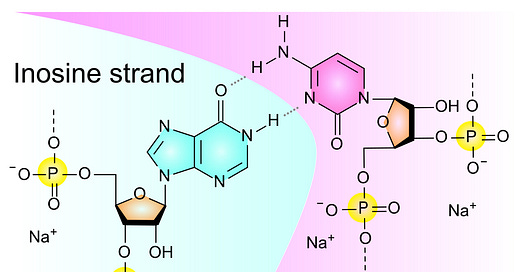Poly(I:C) viral dsRNA mimic studies invalidated by Endotoxin Contamination
Polyinosinic:polycytidylic acid is commonly used to mimic viral double stranded RNA, however it was found in 2019 that prior studies were affected by large Endotoxin contamination
Readers are aware that I always look at the Materials and Methods section of papers to see where the reagents were sourced, and this led me to write about Endotoxin invalidating many Covid19 “Spikeopathy” studies of the Coronavirus1 and Jabs2 that encode synthetic Spike.
Now I have discovered massive Endotoxin has been found in Polyinosinic:polycytidylic acid, Poly(I:C), used to mimic the effects of viral double stranded RNA.
Its structure borrowed from Wikipedia3
Poly(I:C) interacts with toll-like receptor 3 (TLR3), which is expressed at the endosomal membrane of B-cells, Macrophages and Dendritic cells.
Katalin Karikó of BioNTech and Pfizer (and Nobel Prize fame) studied how the Human body responds to foreign dsRNA and mRNA and they deliberately targeted Toll-Like Receptor 3 (TLR3) in Dendritic cells in 2004.4
Note that in the hands of the Pfizer BioNTech jab developer, Endotoxin from Escherichia coli 055:B5 (purchased from Sigma) was at least 10 times more toxic weight for weight than the dsRNA, but I wonder if her Poly(I:C) used in the experiments might have been contaminated with Endotoxin?
Sigma Poly(I:C) was shown by Kowash and coworkers in 2019 by to be heavily contaminated with Endotoxin between Batches and even within the same Batch number.5 Here is part of their Figure 2 showing results of IL-6 induced by the Endotoxin in commercial Poly(I:C) obtained from Sigma and Invivogen.
I recently pointed out that IL-6 generated by Endotoxin contamination of LNP chemicals used for Jabs is self-amplifying.6
Mueller and coworkers7 independently studied Endotoxin contamination of Poly(I:C) in 2019 because they detected the problem in their experiments on mice.
Laboratory reagent Buyers Beware!
GMO Spike Protein carries E coli Endotoxin and enhances Inflammatory Damage to Jabbees
A very useful paper by Petruk et al. published in December 2020 assists greatly in understanding the structures and toxicity of E. coli Endotoxins, also known as LPS (LipoPolySaccharides) from the surface of the bacteria cells and the “smaller” fragments, known as “Lipid A” that break off when the cells are disrupted.
SARS-CoV-2 Spike protein is Not pro-inflammatory in Human Primary Macrophages?
While there is no doubt the Synthetic SARS-CoV-2 Spike protein manufactured in jabbee cells, coded by synthetic mRNA in Covid19 jabs causes immense long-term damage to a generation, it can’t be responsible for the Adverse and sometimes Fatal reactions experienced in
https://en.wikipedia.org/wiki/Polyinosinic:polycytidylic_acid
Septic Shock induced by Plasmid dsDNA and Truncated mRNA has common Sensing Mechanism to Endotoxin in mRNA Jabs
Many people have followed the excellent work of Dr Kevin McKernan analyzing samples of mRNA jabs foisted on billions of people worldwide to prove that the contamination includes fragments of the DNA grown inside E. coli bacteria from which the mRNA designed to code for a Stealth version of the Covid19 virus Spike Protein is made.
H.M. Kowasha, H.G. Potter, M.E. Edye, E.P. Prinssen, S. Bandinelli, J.C. Neill, R. Hager and J.D. Glaziera. 2019. Poly(I:C) source, molecular weight and endotoxin contamination affect dam and prenatal outcomes, implications for models of maternal immune activation. https://www.sciencedirect.com/science/article/abs/pii/S0889159119307457
Empty mRNA Jab LNPs are contaminated with Endotoxin that increases NF-κB
Numerous entities have a desperate need to divert attention away from Endotoxin in Jabs, especially the ones using Lipid Nanoparticles to transfect your cells. One diversionary tactic is to blame the chemicals used in the present mRNA Covid19 Jabs, with the implication that perhaps redesign of the LNPs with new chemicals will fix the problem.
Mueller, F.S., et al., 2019. Influence of poly(I:C) variability on thermoregulation, immune responses and pregnancy outcomes in mouse models of maternal immune activation. Brain Behav. Immun. 1591, 30121–30127. https://www.sciencedirect.com/science/article/abs/pii/S0889159119301217








